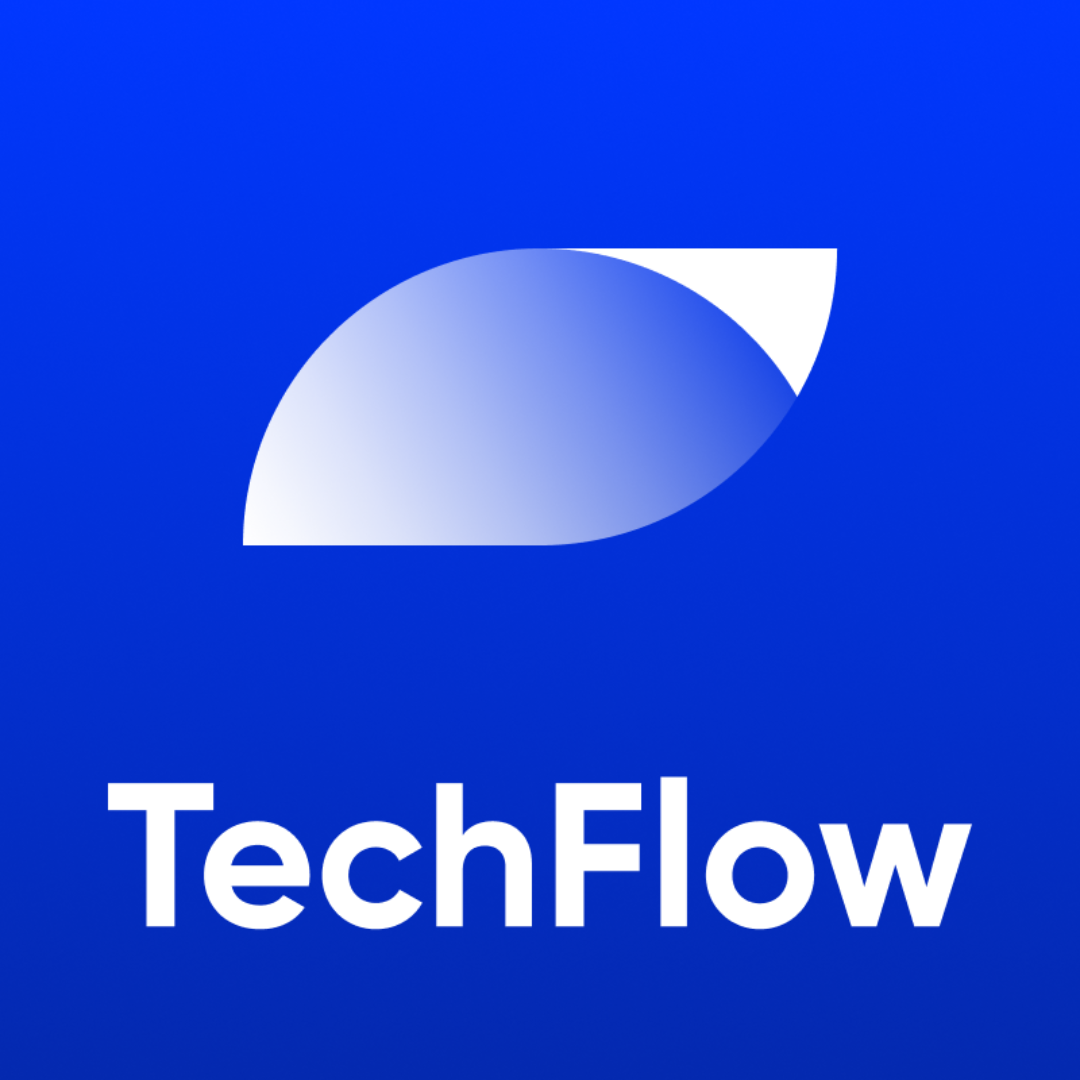Original title: "From grassroots to a market value of 600 billion, Robinhood is entertainment for life"
Original author: Yanz, Liam
"A good financial man, 'the Robin Hood' of finance," a friend once described Vladimir Tenev.
Later, it was this nickname that became the name of a company that changed the financial industry. However, this was not the beginning of the story.
Vladimir Tenev and Baiju Bhatt, the two founders with backgrounds in mathematics and physics respectively from Stanford University, met during a summer research project when they were undergraduates at Stanford University.
Neither of them had anticipated that their future would be deeply bound to a generation of retail investors. They thought they had chosen the retail investors, but in fact, it was the times that chose them.

While studying at Stanford, Tenev began to question the prospects of mathematical research. He was tired of the academic life of "spending several years to study a problem, but in the end, he might get nothing", and he couldn't understand the obsession of his doctoral classmates who were willing to work hard for a meager income. It was this reflection on the traditional path that quietly planted the seeds of his entrepreneurship.
In the fall of 2011, the Occupy Wall Street movement was at its peak, and public dissatisfaction with the financial industry reached its peak. Protesters’ tents were scattered all over Zuccotti Park in New York, and Tenev and Bart, who were far away in San Francisco, could also see the aftermath of this scene from their office windows.
That same year, they founded a company called Chronos Research in New York to develop high-frequency trading software for financial institutions.
However, they soon realized that traditional brokerages kept ordinary investors out of the financial market with high commissions and cumbersome trading rules. This made them start to think: Can the technology that serves institutions also serve retail investors?
At that time, new mobile Internet companies such as Uber, Instagram, and Foursquare emerged, and products designed specifically for mobile terminals began to lead the trend. In contrast, in the financial industry, low-cost brokers such as E-Trade still found it difficult to adapt to mobile devices.
Tenev and Bart decided to ride on this wave of technology and consumption, transforming Chronos into a free stock trading platform for millennials and applying for a broker-dealer license.
Millennials, the internet, free trading—Robinhood combines the three most disruptive elements of this era.
At that time, they did not expect that this decision would usher in an extraordinary decade for Robinhood.
Hunting for millennials
Robinhood set its sights on a blue ocean market that was then ignored by traditional brokerages - millennials.
A survey conducted by traditional financial management company Charles Schwab in 2018 showed that 31% of investors would compare the fees when choosing an intermediary. Millennials are particularly sensitive to "zero fees", and more than half of the respondents said that they would turn to a platform with a more price advantage because of this.
Zero commission trading emerged in this context. At that time, traditional brokerages usually charged $8 to $10 per transaction, but Robinhood completely waived this fee and did not set a minimum account capital threshold. The model of trading with only one dollar quickly attracted a large number of novice investors. With a simple and intuitive interface design that even has a "game feel", Robinhood successfully increased users' trading activity and even cultivated a group of young users who are "addicted to trading".
This change in the charging model eventually forced the industry to transform. In October 2019, Fidelity, Charles Schwab, and E-Trade successively announced that they would reduce the commission for each transaction to zero. Robinhood became the first to carry the banner of zero commission.

Source: Orient Securities
Adopting the Material design style launched by Google in 2014, Robinhood’s gamified interface design even won an Apple Design Award, becoming the first fintech company to win the award.
This is part of success, but not the most critical part.
In an interview, Tenev described the company's philosophy by paraphrasing the character Gordon Gekko from the movie Wall Street: " The most important commodity that I have is information."
This sentence reveals the core of Robinhood’s business model - payment for order flow (PFOF).
Like many Internet platforms, Robinhood's seemingly "free" service actually comes with a more expensive price.
It makes profits by selling users' trading order flow to market makers, but users may not be able to get the best price in the market and think they are taking advantage of zero-commission transactions.
In simple terms, when users place orders on Robinhood, these orders are not sent directly to the open market (such as Nasdaq or NYSE) for execution, but are first forwarded to market makers that cooperate with Robinhood (such as Citadel Securities). These market makers will match buys and sells with extremely small price differences (usually a difference of one thousandth of a cent) to make a profit. In return, market makers will pay Robinhood a "flow fee", which is the payment for order flow.
In other words, Robinhood's free trading is actually making money "out of sight" for users.
Although founder Tenev has repeatedly claimed that PFOF is not a source of profit for Robinhood, the reality is: In 2020, 75% of Robinhood's revenue came from trading-related businesses, and by the first quarter of 2021, this figure rose to 80.5%. Even though the proportion has declined slightly in recent years, PFOF is still an important pillar of Robinhood's income.
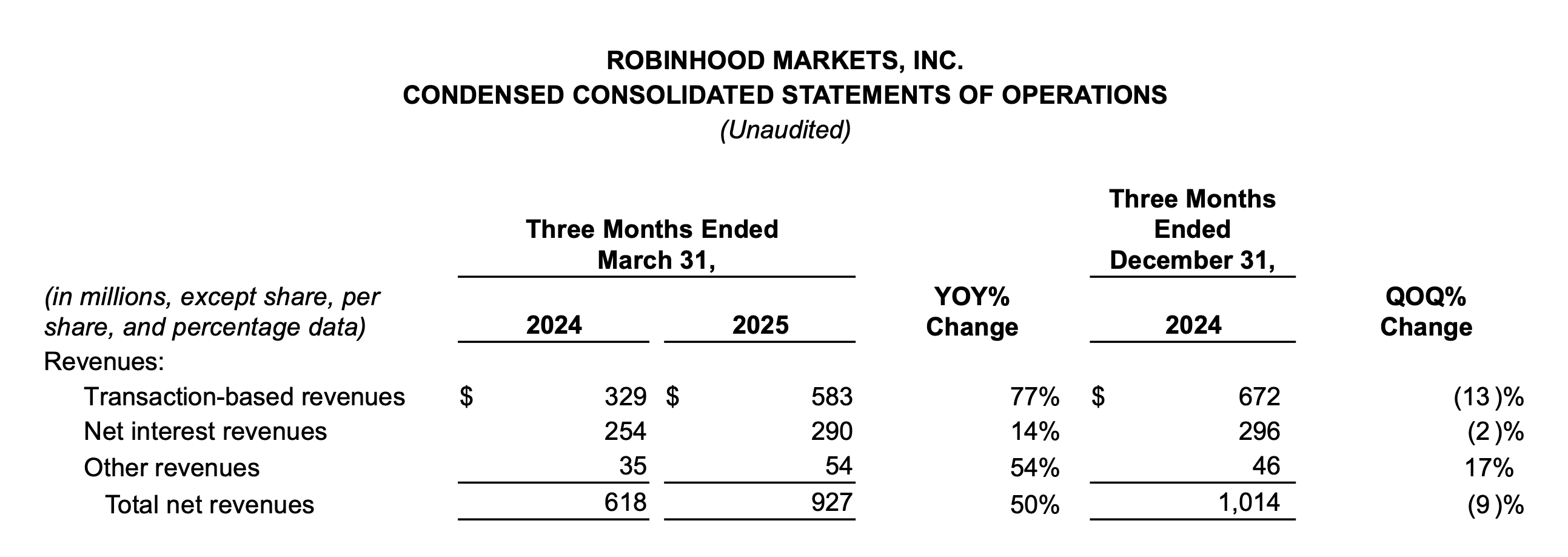
Adam Alter, a marketing professor at New York University, said in an interview: "For a company like Robinhood, it's not enough to just have users. You have to keep them clicking the 'buy' or 'sell' button and lower all the barriers that people may encounter when making financial decisions."
Sometimes, this ultimate experience of "removing barriers" brings not only convenience, but also potential risks.
In March 2020, 20-year-old American college student Karnes found that his account showed a loss of up to $730,000 after trading options on Robinhood, far exceeding his $16,000 principal debt. The young man eventually chose to commit suicide, and the note he left for his family read: " If you read this letter, I am no longer here. Why can a 20-year-old with no income use nearly $1 million in leverage? "
Robinhood has accurately hit the psychology of young retail investors: low threshold, gamification, and social attributes, and has also enjoyed the rewards brought by this design. As of March 2025, the average age of Robinhood users remains stable at around 35 years old.
But everything fate gives you comes with a price tag, and Robinhood is no exception.
Robin Hood, robbing the poor to help the rich?
From 2015 to 2021, the number of registered users on the Robinhood platform increased by 75%.
Especially in 2020, with the COVID-19 pandemic, the US government's stimulus policies and the national investment boom, the platform's users and trading volume both soared, and the managed assets once exceeded US$135 billion.
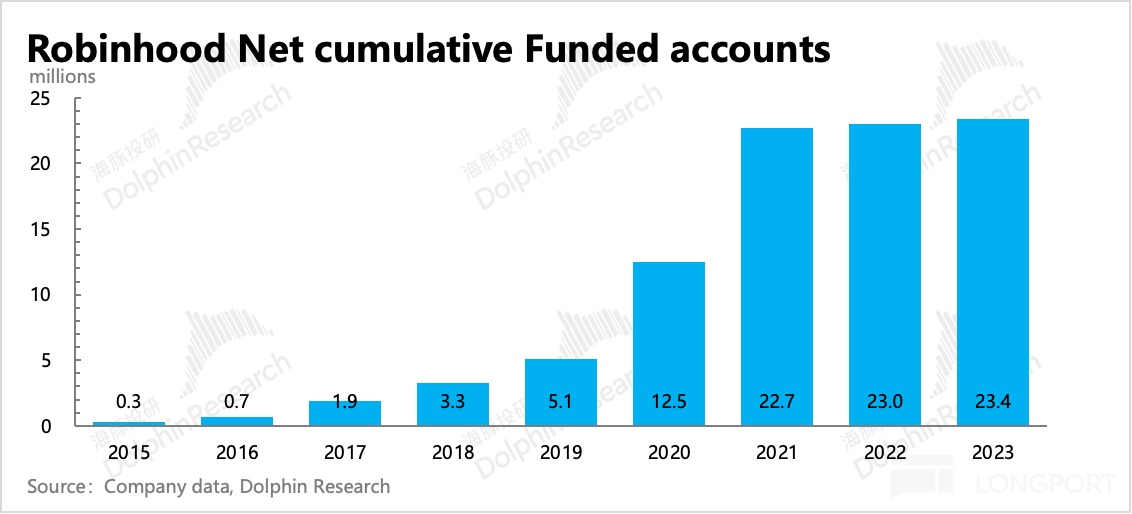
As the number of users surged, so did disputes.
At the end of 2020, the Massachusetts securities regulator accused Robinhood of using "gamification" to attract users with little investment experience, but failed to provide necessary risk control during market fluctuations. Soon after, the U.S. Securities and Exchange Commission (SEC) also launched an investigation into Robinhood, accusing it of failing to obtain the best trading prices for users.
In the end, Robinhood chose to pay $65 million to settle with the SEC. The SEC bluntly pointed out that even considering the commission-free offer, users still lost $34.1 million overall due to price disadvantages. Robinhood denied the allegations, but this storm is destined to be just the beginning.
What really dragged Robinhood into the whirlpool of public opinion was the GameStop incident in early 2021.
This video game retailer, which carries the childhood memories of a generation of Americans, fell into trouble under the impact of the epidemic and became the target of massive short selling by institutional investors. However, thousands of retail investors were unwilling to watch GameStop being crushed by capital. They gathered on the Reddit forum WallStreetBets and used trading platforms such as Robinhood to buy collectively, setting off a "retail short squeeze" war.
GameStop's stock price soared from $19.95 on January 12 to $483 on January 28, an increase of more than 2,300%. A financial carnival of "grassroots resistance to Wall Street" shook the traditional financial system.
However, this seemingly victory for retail investors soon turned into Robinhood’s “darkest hour.”
The financial infrastructure of that year simply could not withstand the sudden trading frenzy. According to the settlement rules at the time, stock transactions required T+2 days to complete settlement, and brokers had to reserve risk margin for user transactions in advance. The skyrocketing trading volume caused Robinhood to pay a sharp increase in margin to the clearing agency.
In the early morning of January 28, Tenev was awakened by his wife and learned that Robinhood had received a notice from the National Securities Clearing Corporation (NSCC) requiring it to pay a risk margin of up to US$3.7 billion . Robinhood's capital chain was instantly pushed to its limit.
He contacted venture capitalists overnight and raised funds to ensure that the platform would not be dragged down by systemic risks. At the same time, Robinhood was forced to take extreme measures: restricting the purchase of "Internet celebrity stocks" such as GameStop and AMC, and users can only sell.
The decision immediately sparked public outrage.
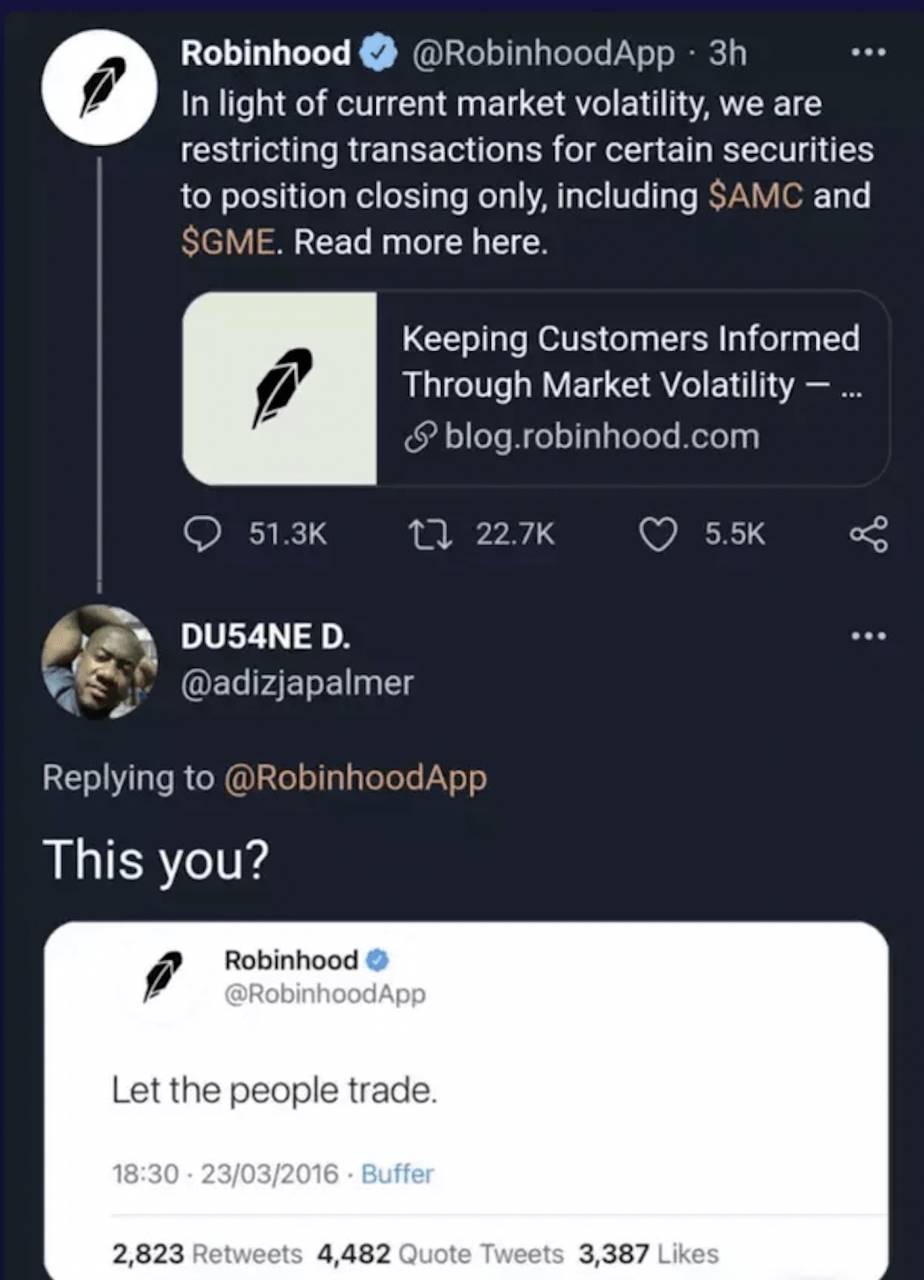
Millions of retail investors believe that Robinhood has betrayed its promise of "financial democratization" and have criticized it for bowing to Wall Street forces. There are even conspiracy theories accusing Robinhood of secretly colluding with Citadel Securities (its largest order flow partner) to manipulate the market to protect the interests of hedge funds.
Cyberbullying, death threats, and malicious reviews followed one after another. Robinhood suddenly went from being a "retail investor friend" to a target of public criticism. The Tenev family was forced to take shelter and hired private security.
On January 29, Robinhood announced that it had urgently raised $1 billion to maintain operations, and then raised several rounds of financing, eventually raising a total of $3.4 billion. At the same time, congressmen, celebrities and public opinion kept chasing it.
On February 18, Tenev was summoned to attend a U.S. congressional hearing. Facing questioning from congressmen, he insisted that Robinhood's decision was made under settlement pressure and had nothing to do with market manipulation.
Despite this, doubts have never subsided. The Financial Industry Regulatory Authority (FINRA) launched a thorough investigation into Robinhood and ultimately issued the largest single fine in history - $70 million, including a $57 million fine and $13 million in customer compensation.
The GameStop incident became a turning point in Robinhood’s history.
The financial crisis severely damaged Robinhood's image as a "protector of retail investors", and its brand reputation and user trust were severely damaged. For a time, Robinhood became a "survivor in the cracks" that was not only dissatisfied by retail investors but also under the watchful eyes of regulators.
However, this incident also prompted US regulators to reform the clearing system and shorten the settlement cycle from T+2 to T+1, which had a long-term impact on the entire financial industry.
In the wake of the crisis, Robinhood pushed forward with its long-planned IPO.
On July 29, 2021, Robinhood was listed on the Nasdaq under the ticker "HOOD", with an issue price set at $38 and a valuation of approximately $32 billion.
However, the IPO did not bring Robinhood the expected capital feast. On the first day of listing, the stock price fell at the opening and finally closed at US$34.82, down 8% from the issue price. Although it rebounded briefly due to the retail enthusiasm and institutional buying (such as ARK Invest), the overall trend has been under pressure for a long time.
The disagreement between Wall Street and the market is obvious - whether they are optimistic about it as the "financial portal for the retail era" or worried about its controversial business model and future regulatory risks.
Robinhood stands at the crossroads of trust and suspicion, and has officially entered the reality test of the capital market.
But at that time, few people noticed a signal hidden between the lines of the prospectus - in the S-1 document submitted by Robinhood, the word "Crypto" was mentioned 318 times.
Its unintentional high frequency appearance is actually a declaration of a strategic shift.
Crypto is the new narrative that Robinhood has quietly opened up.
Crashing into encryption
As early as 2018, Robinhood had quietly tested the cryptocurrency business and took the lead in launching Bitcoin and Ethereum trading services. At that time, this layout was more like a supplement to the product line and was far from becoming a core strategy.
But market enthusiasm soon changed all that.
In 2021, The New Yorker described Robinhood as follows: "A zero-commission platform that offers both stocks and cryptocurrency trading, committed to becoming an enlightened version of Wall Street, with a mission to 'democratize finance for all.'"
The growth of data also confirms the potential of this track:
In the fourth quarter of 2020, approximately 1.7 million users traded cryptocurrencies on the Robinhood platform. By the first quarter of 2021, this number soared to 9.5 million, an increase of more than 5 times in a single quarter.
In the first quarter of 2020, crypto trading revenue accounted for about 4% of the company's total trading revenue. By the first quarter of 2021, this figure surged to 17%, and in the second quarter it exploded to 41%.
At the beginning of 2019, Robinhood's cryptocurrency assets were only $4.15 million. By the end of 2020, this figure had skyrocketed to $35.27 million, an increase of more than 750%. In the first quarter of 2021, the custody scale soared to $1.16 billion, a year-on-year increase of more than 2,300%.

At this point, cryptocurrency has gone from being a fringe product to one of Robinhood’s revenue pillars, clearly positioned as a growth engine. As they wrote in the filing: “We believe that cryptocurrency trading opens up new space for our long-term growth.”
But what exactly happened that caused Robinhood’s cryptocurrency business to explode in just one or two quarters?
The answer also appears in the S-1 prospectus. Remember the crazy Dogecoin in 2021? Robinhood is the driving force behind the Dogecoin wave.
The S‑1 filing specifically states: “In the three months ended June 30, 2021, 62% of crypto trading revenue came from Dogecoin, compared to 34% in the prior quarter.”
To cater to user demand, Robinhood announced plans in August 2021 to launch cryptocurrency deposit and withdrawal features, allowing users to freely transfer assets such as Bitcoin, Ethereum, Dogecoin, etc. into or out of their wallets.
Half a year later, at the LA Blockchain Summit, Robinhood officially released the multi-chain Robinhood Wallet beta version, which will be open to iOS users in September 2022 and fully launched in 2023.
This move marks the beginning of Robinhood's official transformation from a "centralized brokerage" to a "digital asset platform."
However, just when Robinhood was at a critical stage of accelerating its transformation with the help of the crypto craze, a legendary man at the time set his sights on it - Sam Bankman-Fried (SBF) .
The founder and CEO of FTX, who was in the limelight at the time, was known for his radical expansion methods and disruptive ambitions in the financial industry.
In May 2022, SBF quietly bought approximately 7.6% of Robinhood shares , worth approximately US$648 million , through its holding company Emergent Fidelity Technologies .
After the news was made public, Robinhood's stock price soared by more than 30% in after-hours trading.
SBF said in a 13D filing with the U.S. Securities and Exchange Commission (SEC) that he bought Robinhood because he "believed it to be an attractive investment " and promised that he had no plans to seek control or intervene in management. However, the document also retained the statement that "the intention to hold shares may be adjusted in the future according to circumstances", leaving ample room for maneuver.

In fact, SBF's move is difficult to be simply interpreted as a financial investment.
At that time, FTX was actively developing the US compliance market, trying to get rid of its identity as a "pure crypto exchange" and penetrate into traditional financial and securities businesses. Robinhood, with its huge retail user base and compliance qualifications, was the ideal bridge.
There were rumors in the market that SBF intended to promote deeper cooperation with Robinhood and even attempt a merger and acquisition. Although SBF publicly denied the rumor, he never ruled out the possibility in the future.
However, SBF's layout did not lead to the ideal "win-win" situation.
At the end of 2022, FTX collapsed and SBF was accused of fraud, money laundering and financial crimes. In January 2023, the US Department of Justice officially seized approximately 56 million Robinhood shares held by SBF through its holding company, with a market value of approximately US$465 million at the time.
This equity, which originally symbolized the "Crypto Financial Alliance", eventually became a hot legal evidence.
It was not until September 1, 2023 that Robinhood repurchased the shares from the United States Marshals Service (USMS) for US$605.7 million , completely resolving the potential risk of holding shares.
What is sad is that based on Robinhood's current market value of $86 billion, the 7.6% stake that SBF once owned would be worth about $6.5 billion if it had been maintained to this day, which is more than 10 times the original cost.
It turns out that this "attractive investment" that SBF considered was attractive enough.
Take off, stock price
If the GameStop incident was Robinhood's baptism of crisis, then Robinhood in 2025 has officially ushered in its own highlight moment.
All this had been foreshadowed.
In the fourth quarter of 2024 , Robinhood's key indicators hit new highs:
Custody assets, net deposits, gold subscribers, revenue, net profit, adjusted EBITDA and earnings per share all exceeded expectations;
Single-quarter revenue exceeded $1.01 billion, net profit reached $916 million, gold subscribers exceeded 2.6 million, and adjusted EBITDA reached $613 million......
Cryptocurrency trading volume surged to $71 billion, and crypto business revenue increased 700% year-on-year, generating $358 million in revenue in a single quarter.
It is worth noting that in the fourth quarter financial report, Robinhood founder Tenev said: "We see a huge opportunity in front of us because we are working to enable anyone, anywhere to buy, sell or hold any financial asset and conduct any financial transaction through Robinhood ."
This is probably a small foreshadowing.
On February 14, 2025, just two days after the financial report was released, Robinhood's stock price reached its first peak in 2025 at $65.28.
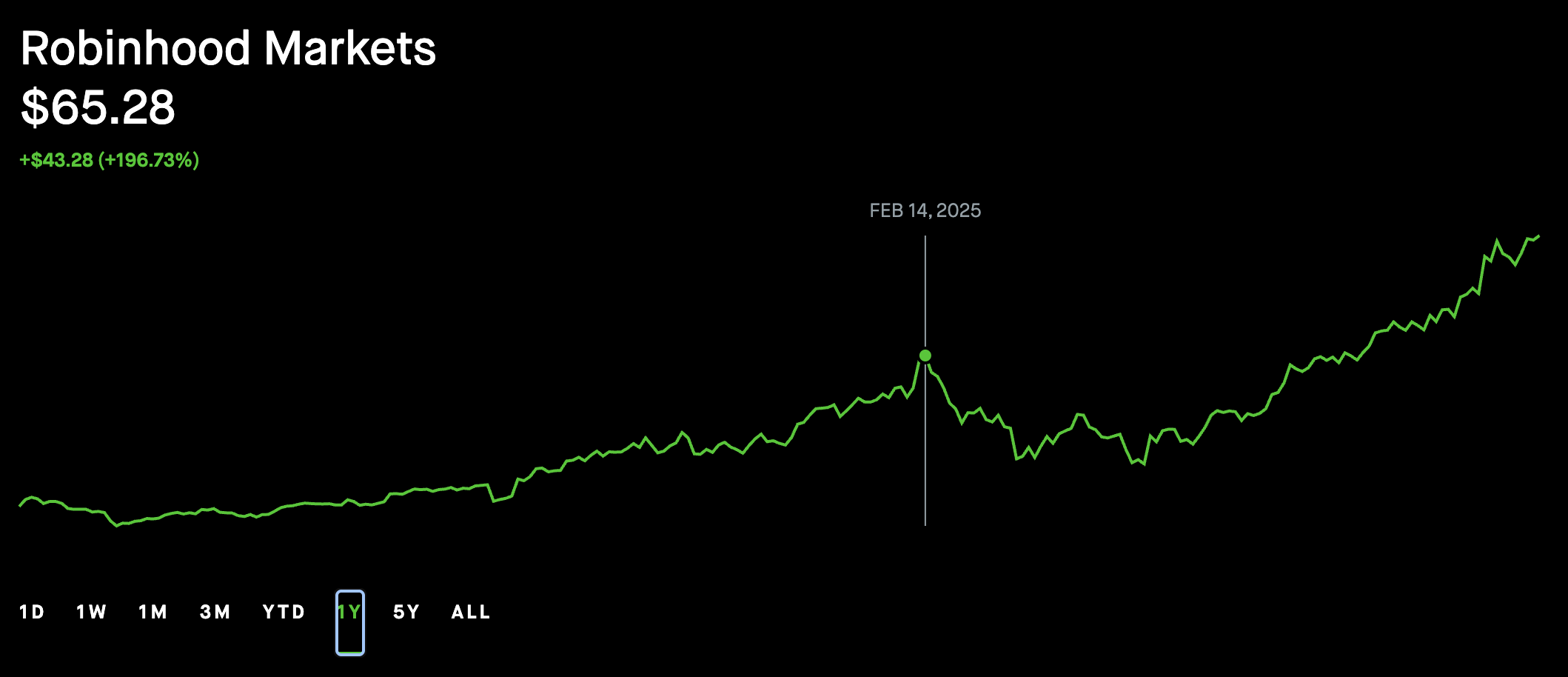
But what really ignited this stock price surge was the resonance between the global financial and crypto markets.
With Trump's election and the US policy shifting towards "crypto-friendly", Robinhood's regulatory risks have gradually been alleviated.
On February 21, 2025, the U.S. SEC Enforcement Division officially notified Robinhood Crypto that it had ended its year-long investigation into its crypto business, custody processes, and payment order flows, and decided not to take any enforcement action. This letter not only cleared the policy barriers to Robinhood's future expansion of its crypto business, but also became an important catalyst for the stock price's breakthrough rebound.
Then, Robinhood delivered a powerful blow.
On June 2, 2025 , Robinhood officially announced the completion of its acquisition of Bitstamp , one of the world's oldest cryptocurrency exchanges, for US$65 million .
Bitstamp was renamed "Bitstamp by Robinhood" and fully integrated into the Robinhood Legend and Smart Exchange Routing systems. This strategic acquisition not only brought Robinhood access to compliant assets and global market layout, but also pushed it from a retail brokerage to the ranks of global crypto exchanges competing with Coinbase and Binance.
The next day, the stock price broke through $70 .
If the acquisition of Bitstamp is an important step for Robinhood to go global, then the next move announces Robinhood's big step into the Web3 capital market.
Remember Tenev's previous announcement? " Anyone, any time, any financial asset, any transaction goes one step further ."
On June 30, 2025, Robinhood announced its official entry into the blockchain securities field, allowing European users to trade more than 200 US stocks and ETFs on the Arbitrum network through blockchain-based tokens, including stocks of well-known companies such as Nvidia, Apple and Microsoft.
Not only that, Robinhood also announced the development plan of its own Layer-2 blockchain " Robinhood Chain ".
The market reacted significantly to this, with Robinhood's stock price soaring in a single day, reaching a monthly increase of 46%, and breaking through $100 during intraday trading on July 2, setting a record high.
Although the market experienced a brief pullback afterwards due to the debunking of rumors about OpenAI's equity tokenization, analysts generally believe that Robinhood has completed its gorgeous transformation from a "retail brokerage" to a "financial technology platform", and blockchain securities will become its next long-term growth engine.
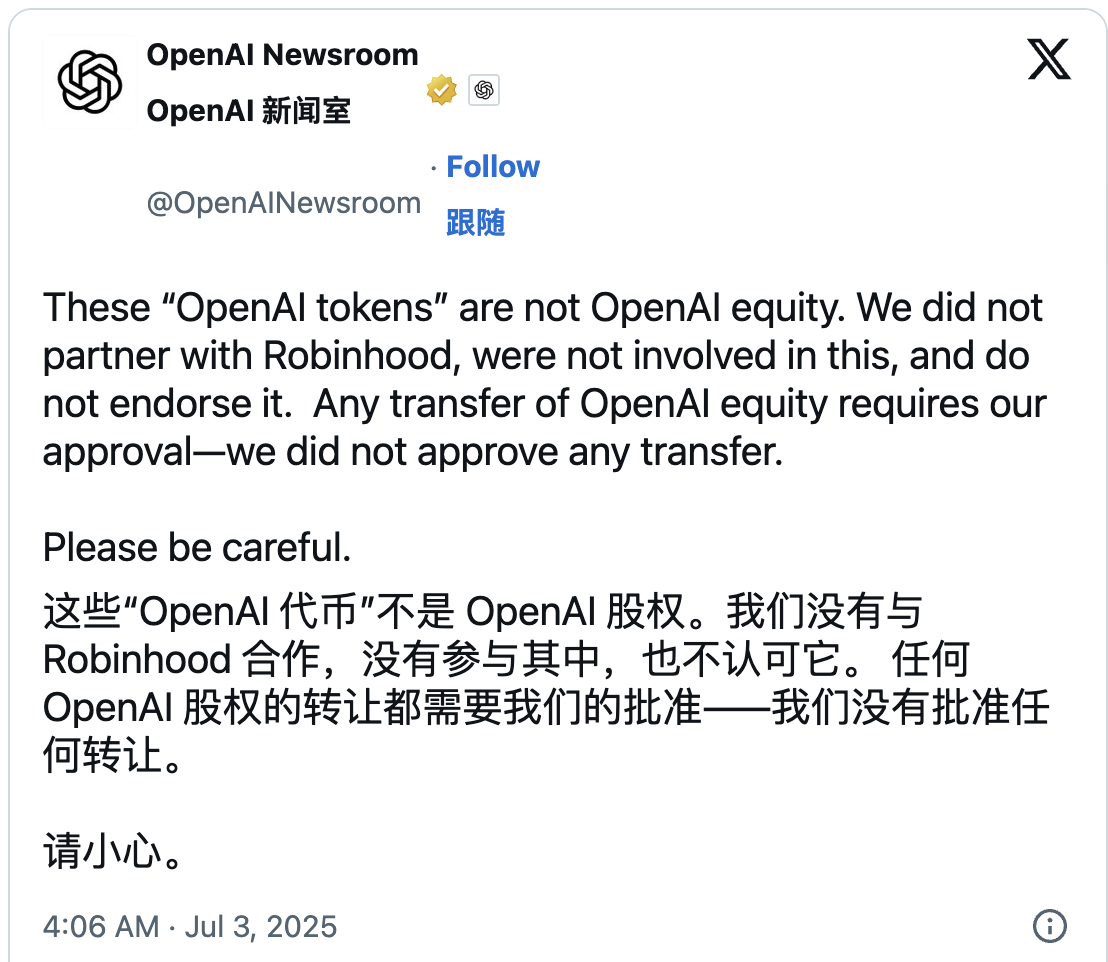
As of now, Robinhood’s stock price has been firmly around $100 , with a year-to-date increase of nearly 150% . Its market value has exceeded $88 billion (about 630 billion yuan) , far exceeding expectations when it went public.
From grassroots to today, Robinhood, with a market value of 86.7 billion, is no longer what it used to be. From being the "target of public criticism" in the GameStop storm in 2021 to being a trendsetter in the wave of financial and crypto integration in 2025, Robinhood has not only experienced the ultimate test of the capital market, but also completed its accelerated reconstruction in five years.
If history chose Robinhood back then, then at this moment, Robinhood has finally become the player that can lead history.
Today, Tenev could probably tell his college self, who was concerned about math as a career, “ You’ve spent several years exploring a specific problem, and at least you’re not in vain .”


